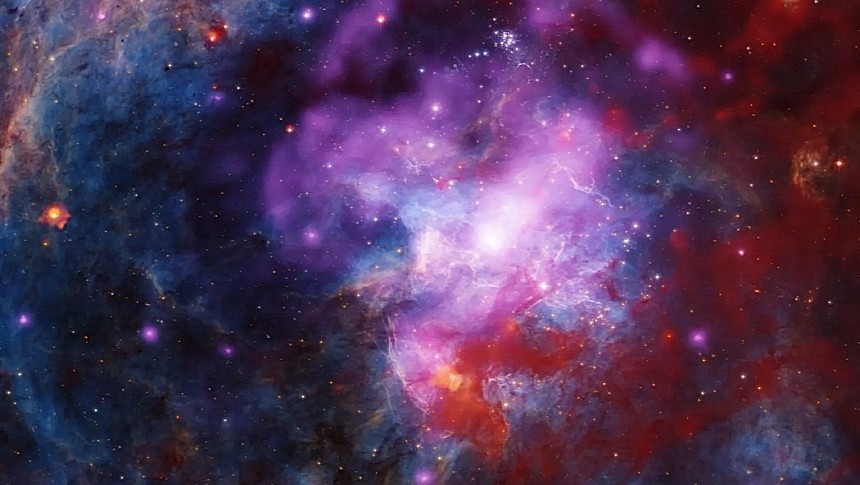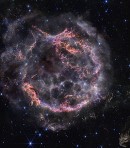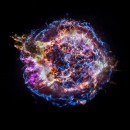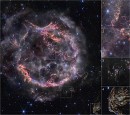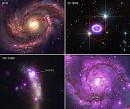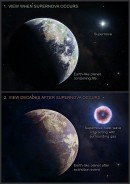The Universe is a fascinating place, and thanks to the many telescopes currently in use, we regularly get to enjoy vistas that we would never have imagined possible a few short decades ago. Like say the remnants of not one, but two exploded stars fighting for attention in the same pic.
What you're looking at in the main image of this story is the remnant of a supernova called as 30 Doradus B (30 Dor B). It's not the usual image you get from a single telescope, but a composition that uses images captured by no less than four of them.
30 Dor B is located so far away from our planet that it'll make your head spin: 160,000 light-years. It resides in an offshoot region of the Milky Way galaxy we know as the Large Magellanic Cloud, which is, in itself, a place of celestial wonders.
It is there where, for the past 10 million years or so, stars have been born with such a fervor it's impossible to describe and properly understand. As a result, it's filled with clouds of superheated gas and energy shocks that put on a show like few regions of the observable space do.
As said, no less than four telescopes were used to put this pic together. The first is the Chandra X-ray Observatory, which supplied no less than over two million seconds of observing time for the project, and whose input is seen in the photo in purple.
In orange and Cyan we get the images supplied by the Blanco telescope in Chile, while the red infrared data comes from the Spitzer Space Telescope. The black and white optical data is the result of work conducted by the Hubble Space Telescope.
So, what are we looking at? The astronomers behind this research, part of a team led by Wei-An Chen from the National Taiwan University in Taipei, Taiwan, say the image shows something that cannot be the result of a single supernova.
More specifically, the faint shell of X-rays in the area spans no less than 130 light-years across. Also, at the center of particle winds in the area there seems to be a pulsar.
This can only happen, according to astronomers, if more than a supernova is involved. More specifically, a first one which seems to have occurred about 5,000 years ago, when a massive star exploded. This one is probably responsible for the birth of the pulsar (a rotating neutron star that releases beams of electromagnetic radiation out its poles) and the X-rays present in the center of the region.
The X-ray shell, however, is probably the result of an older supernova, whose effects still make themselves felt to all those who look that way.
The results of this research were published by the team in the Astronomical Journal, and were made public by NASA this week. Hopes are that these findings will help us humans get a better understanding of how massive stars live their lives, but also of the effects of supernovas.
30 Dor B is located so far away from our planet that it'll make your head spin: 160,000 light-years. It resides in an offshoot region of the Milky Way galaxy we know as the Large Magellanic Cloud, which is, in itself, a place of celestial wonders.
It is there where, for the past 10 million years or so, stars have been born with such a fervor it's impossible to describe and properly understand. As a result, it's filled with clouds of superheated gas and energy shocks that put on a show like few regions of the observable space do.
As said, no less than four telescopes were used to put this pic together. The first is the Chandra X-ray Observatory, which supplied no less than over two million seconds of observing time for the project, and whose input is seen in the photo in purple.
In orange and Cyan we get the images supplied by the Blanco telescope in Chile, while the red infrared data comes from the Spitzer Space Telescope. The black and white optical data is the result of work conducted by the Hubble Space Telescope.
So, what are we looking at? The astronomers behind this research, part of a team led by Wei-An Chen from the National Taiwan University in Taipei, Taiwan, say the image shows something that cannot be the result of a single supernova.
More specifically, the faint shell of X-rays in the area spans no less than 130 light-years across. Also, at the center of particle winds in the area there seems to be a pulsar.
This can only happen, according to astronomers, if more than a supernova is involved. More specifically, a first one which seems to have occurred about 5,000 years ago, when a massive star exploded. This one is probably responsible for the birth of the pulsar (a rotating neutron star that releases beams of electromagnetic radiation out its poles) and the X-rays present in the center of the region.
The X-ray shell, however, is probably the result of an older supernova, whose effects still make themselves felt to all those who look that way.
The results of this research were published by the team in the Astronomical Journal, and were made public by NASA this week. Hopes are that these findings will help us humans get a better understanding of how massive stars live their lives, but also of the effects of supernovas.
